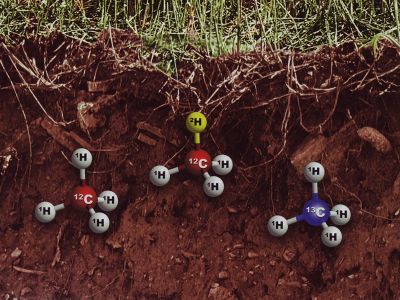Environmental chemists currently use changes in isotopic compositions to identify the source of organic contaminants and to estimate the rate and extent of their biological degradation.

Organic compounds are characterized by a unique isotopic composition that can be used as their "fingerprint". Environmental chemists currently use changes in isotopic compositions to identify the source of organic contaminants and assess the rate and extent of their biological degradation in the environment by examining stable isotopes that are unique to each and every compound.
Scientists from Germany recently published an issue in the journal "Environmental Science and Technology" that completely describes the significant development that has taken place in this field in recent years.
Human activity leads to the production and use of huge amounts of chemicals which - intentionally or not - can be released into the environment. Examples of this include various pesticides used in agriculture to combat fungi, insects and weeds, contamination of groundwater with fuel and oil residues from leaking underground tanks, and medicinal substances that reach aquatic environments through waste treatment plants or from agricultural fields where fertilizers containing antibiotics are spread.
Environmental chemists deal with the presence of these chemicals in the environment. They deal with important issues such as the rate of spread of the contamination and the exact identity of the final disintegrants. However, evaluating change processes in complex environments is a challenging task. The concentrations of pollutants decrease over time not only due to their biological decomposition but also due to their mixing in the liquid environment or their absorption into the soil layer. It can be erroneously concluded that such an apparent disappearance of a pollutant from a certain system is a change, and in addition, makes it difficult to quantify the exact extent of the pollution that has disappeared.
In a key article in the special issue on stable isotopes, a team of researchers summarizes the ability of examining unique isotopes-compounds to be used as a tool to identify contaminated reservoirs and to assess the reaction of organic chemicals with the environment. In additional articles, a wide variety of researchers present the current set of information available in this field.
Analytical methods for examining unique isotopes-compounds developed from the fields of geosciences (such as geochemistry) and are widely used today in diverse fields including environmental sciences. This method is based on a unique isotopic signature of each and every element in nature. For example, carbon has two stable isotopes carbon-12 and carbon-13 that do not decay like the radioactive isotope carbon-14. In nature, these isotopes exist in their characteristic ratio. Every compound that exists over time carries within it a characteristic isotopic composition (fingerprint) derived from the starting materials used to prepare it. This fact, for example, makes it possible to differentiate between natural pollutants and man-made pollutants or to map the unique origin of the pollutants in certain factories.
One particularly important feature of isotopic analysis, from the point of view of an environmental chemist, is that changes in the isotope compositions of individual pollutants allow the identification of decomposition processes. These processes can be quantified, regardless of the management of substance concentrations. Based on the rate of isotopic change, calculations can be made regarding the rate of decomposition reactions and even the final decomposition products. For example, a characteristic shift in the isotopic signature makes it possible to distinguish between microbial changes and photochemical changes that pass through pesticides such as atrazine that originate on the surface of plants or in rivers and lakes.
One of the authors notes that: "The scientific discussion regarding the origin of the effects of the isotopes and its consequences encourages a professional dialogue between "pure" (computational) chemists, earth and environmental scientists and ecologists. You can learn a lot from each other."
On this occasion, the combination of scientists understood how isotope analysis and insights from this method can be used in different fields. The aforementioned issue, on the other hand, mainly contains articles from the field of environmental chemistry and geochemistry. The researcher explains, "The basic principles of these methods are the same. We differ mainly in the time horizon and the level of sophistication that we need to understand our processes. In environmental chemistry this means hours to decades, in chemistry it is usually in fractions of a second, and the question in earth sciences can be spread over much longer time intervals, up to millions of years."
